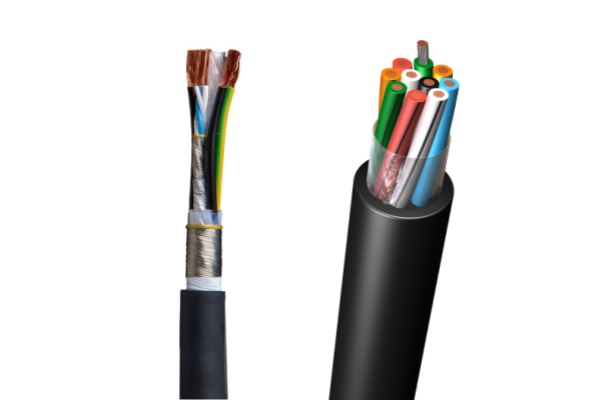

Control cables are essential components in industrial applications, தொடர்பு எளிதாக்கும், signal transmission, and control between machinery and automation systems. Without these cables, modern industries wouldn’t function efficiently or safely. These specialized cables are engineered to transmit electrical signals with minimal interference, ensuring precise operations across diverse environments, from factory floors to harsh outdoor settings.
இந்த கட்டுரையில், VERI Cable will explore the common types of control cables used in industrial applications, focusing on their design, பொருட்கள், and the specific environments where each type is most suitable. By understanding the different types, businesses can make informed decisions to optimize performance, reduce downtime, and enhance safety.


Control cables are multi-conductor cables designed to carry low-voltage signals for the control and regulation of equipment. These cables are typically used in automation, manufacturing, energy, transportation, and other industries where precise control is essential.
They differ from power cables, which are meant to carry electrical current, in that they focus on signal integrity and minimal interference. தி insulation and shielding of control cables are crucial to ensuring they transmit signals without degradation or electrical noise interference.
இப்போது, let’s explore the various types of control cables commonly used in industrial applications:
Polyvinyl chloride (PVC) is one of the most widely used materials for control cables due to its versatility and cost-effectiveness. PVC control cables are typically used in industrial settings where moderate mechanical and chemical protection is required.
PVC control cables are most effective in dry or mildly damp environments and can be used for light mechanical stress applications. While they are widely used, PVC cables have limited resistance to oils and chemicals, which may make them unsuitable for certain harsh environments.
Polyurethane (PUR) control cables are known for their superior durability and resistance to abrasion, எண்ணெய்கள், மற்றும் ரசாயனங்கள். PUR control cables are designed to withstand high mechanical stress and harsh environments, making them a popular choice for more demanding industrial applications.
These cables are preferred for applications where high mechanical stress is expected, such as dragging chains, mobile automation systems, and harsh industrial environments.
Shielded control cables are designed to protect signal integrity in environments with high electromagnetic interference (EMI) or radio-frequency interference (RFI). These cables feature a shielding layer, typically made from materials like aluminum foil or copper braid, which helps reduce signal noise and interference.
In industries where sensitive control systems operate near power cables or heavy machinery, shielded control cables are essential to avoid signal degradation and ensure system reliability.
Instrumentation control cables are used where accurate and reliable signal transmission is critical for process control. These cables are specifically designed to handle low-voltage signals and are commonly used in industries where precision and data integrity are crucial, such as petrochemical, power generation, and pharmaceutical industries.
Instrumentation cables are critical for the smooth operation of control systems, particularly in industries with strict regulatory requirements and sensitive processes.
Flexible control cables are designed to maintain signal integrity even in dynamic applications, where constant motion or vibration occurs. These cables are used in industries where machinery is in constant motion, such as automation, robotics, and material handling systems.
The flexibility of these cables allows them to be used in machinery with moving parts without the risk of breakage or signal loss.
Halogen-free control cables are designed to minimize the release of toxic gases in the event of a fire. These cables are made without halogens like chlorine, bromine, or fluorine, which can emit harmful gases when burned. Halogen-free cables are becoming increasingly important in industries with strict fire safety standards, such as transportation, தரவு மையங்கள், and commercial buildings.
In industries where fire safety is critical, halogen-free control cables help minimize the risk of toxic exposure during emergencies.
Variable Frequency Drive (VFD) cables are specialized control cables used to connect motors to variable frequency drives. These cables are designed to withstand the high levels of electrical noise and harsh conditions typically found in motor drive applications.
VFD cables ensure smooth and efficient motor operation, particularly in industrial applications requiring precise motor control.
Tray cables are designed for installation in trays, conduits, and ducts in industrial settings. These cables are known for their durability, ease of installation, and ability to handle various electrical and mechanical stresses.
Tray cables are used extensively in industrial plants where complex control and power systems are required to operate machinery and automation systems.
Armored control cables are designed for applications where high mechanical protection is necessary. These cables feature an additional layer of armor, typically made from steel wire or tape, which shields the cable from external damage.
Armored control cables are essential for environments where cables are exposed to potential physical damage, ensuring continuous operation even under severe conditions.
Control cables are vital in the smooth operation of industrial systems. From PVC control cables used in basic automation to armored and VFD cables designed for the most extreme conditions, each type serves a specific role in optimizing industrial processes. Understanding the common types of control cables, அவர்களின் விண்ணப்பங்கள், and key characteristics can help industries select the right cables for their specific needs, improving safety, திறன், and reliability across operations.
In today’s fast-paced industrial environments, choosing the right control cable is not just about performance; it is also about future-proofing against potential risks and ensuring compliance with industry regulations. With the right cable, industries can minimize downtime, reduce costs, and ensure the safety of both personnel and equipment.
When people hear the term mineral insulated cable, many immediately think of harsh environments like…
As telecommunication networks and power transmission systems grow rapidly, the demand for reliable and cost-effective…
In large-scale oil and gas projects, industrial cables are not just accessories—they are the "nervous…
மின் இணைப்புகள் உலகில், cable lugs—also known as cable ears or cable terminals—are…
When choosing the right rubber cable for an electrical engineering project, it is critical to…
Dear partners and customers: January 29th, 2025 is the Chinese Lunar New Year – Spring…